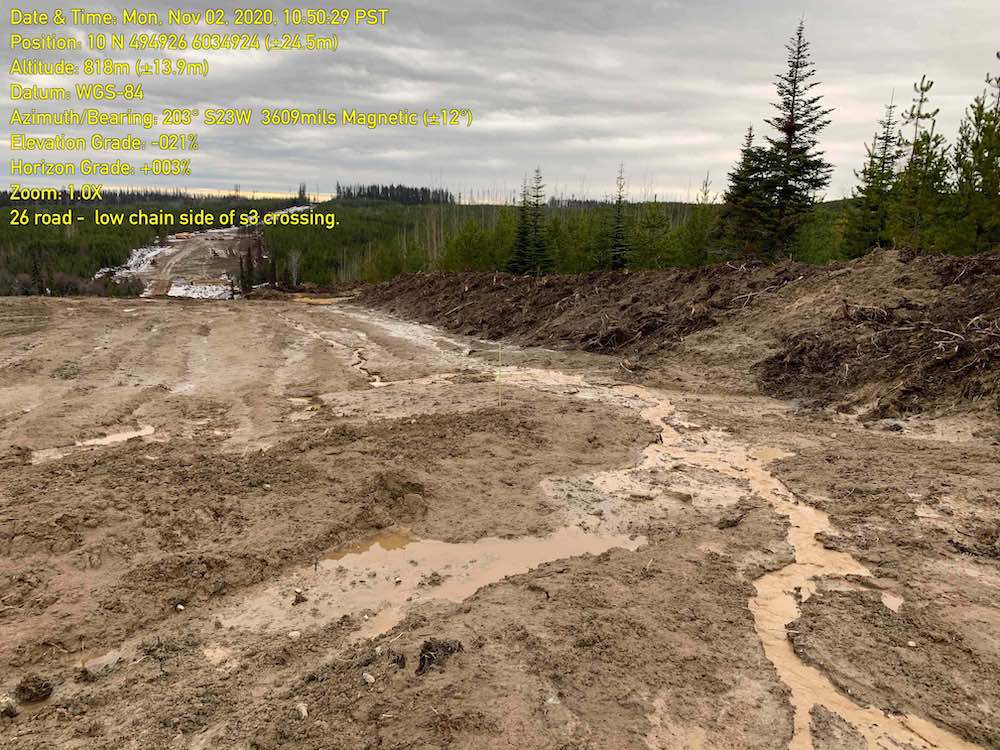A damning provincial report indicates that fears that Coastal GasLink’s pipeline work is damaging water quality and the environment may be well-founded.
The report, which was posted by B.C.’s Environmental Assessment Office in September, says the company continues to violate its Environmental Management Plan by allowing sediment and contaminants from the project to flow into rivers and streams.
As a result, the EAO has recommended an administrative penalty under the province’s Environmental Assessment Act, the Ministry of Environment and Climate Change said in an email to The Tyee.
It added that administrative penalties of up to $750,000 could be imposed for each day Coastal GasLink remains out of compliance. Court-imposed penalties of up to $1 million for a first conviction and up to $2 million for subsequent convictions are also possible under the act, the ministry said.
“Continued non-compliance with these requirements may result in additional enforcement under the Environmental Assessment Act,” compliance and enforcement officers warn Coastal GasLink in a 65-page report that outlines details of inspections that took place in late April and early May.
The report also includes responses from the company, which blamed, in part, a provincial health order earlier this year limiting its workforce after COVID-19 outbreaks occurred at two of its work camp accommodations.
It comes as members of the Wet’suwet’en Nation and their supporters block access to a Coastal GasLink work site over fears that drilling under the Morice River will have negative impacts on the watershed.
In a recent interview, Gidimt’en Clan member Molly Wickham, whose Wet’suwet’en name is Sleydo’, said she had witnessed an increase in silt and sedimentation in the river, which is known as Wedzin Kwa to the Wet’suwet’en.
She said industrial activities like logging and trenching through streams to bury the pipeline have combined to extend the period when the river is undrinkable due to silt from weeks into months. Normally, the problem is only during spring runoff.
“My biggest fear is that we’re never going to be able to drink from Wedzin Kwa again... and that it will impact spawning salmon,” Wickham recently told The Tyee.
In July, the EAO issued a separate warning to Coastal GasLink after security guards wrongly blocked Wickham from attempting to monitor pipeline construction in her clan’s traditional territory.
The incident was not isolated, Wickham said at the time, with pipeline security blocking access to the route for several weeks this spring as right-of-way clearing took place near the Morice River.
This is the company’s second warning over water-quality issues in less than a year. In October and November 2020, inspections by the EAO found that Coastal GasLink activities were harming watersheds, also as a result of sediment runoff and inadequate erosion control.
At that time, compliance and enforcement officers found measures to prevent runoff from entering waterways, such as fencing, berms and straw bales, were not properly installed or maintained, causing sediment to flow into fish-bearing streams, risking sensitive fish habitat and introducing contaminants into the watershed.
The company was ordered to hire an independent erosion and sediment control auditor to submit biweekly monitoring reports starting in February, something the ministry confirmed Coastal GasLink has done.
It was also ordered to pay a $10,000 inspection fee.
While last fall’s inspections focused on 400 kilometres of the pipeline route to the north and east of Prince George, the inspections in April and May took place at various locations between Chetwynd and Smithers. They found that Coastal GasLink was in compliance in only one of nine requirements reviewed by compliance and enforcement officers.
“Over the course of the inspection EAO observed various instances where sediment-laden project water had left the right of way and transported to environmentally sensitive receptors [watercourses],” the officers said in their report.
The report documents dozens of sites where sediment was seen flowing into watercourses and wetlands and where erosion and runoff control measures were not functioning or were overwhelmed.
It also found that the company had not posted signs to identify sensitive environmental features, as required by the province, and that it had conducted inadequate streambank restoration.
The inspections also flagged issues with maintaining hydrocarbon storage systems, particularly at 9A Lodge, a work camp that has experienced several previous diesel and contaminant spills.
The company was found to be in compliance in only one area. Investigating officers noted that signs flagging whitebark pine, a tree listed as endangered under the Species at Risk Act, had been installed along the pipeline right-of-way. The company was previously issued a stop-work order for failing to collect cones from the rare alpine trees it logged while clearing the pipeline route.
Although the EAO inspections examined sites in roughly 500 kilometres of the 670-kilometre pipeline, several non-compliance issues were raised in Wet’suwet’en territory, specifically in the area near the Morice River and the Unist’ot’en Healing Centre, where efforts to block pipeline construction on the territory began more than a decade ago.
At a location where the pipeline route skirts Gosnell Creek, a major tributary of the Morice, the report describes how construction caused sediment to flow into an adjacent lake at “multiple locations.” Photos included in the report show brown water staining snow and ice covering the lake’s surface.
In response, Coastal GasLink blamed “natural tannins leaching out of the forest during spring melt,” something it said is a natural process and should not be associated with the project’s compliance record.
But compliance and enforcement officers disagreed, saying no evidence had been submitted to support the claims.
“Similar lakes in the area did not appear to show the same visible amount of sediment-laden runoff transporting into them,” they said in the report. “On the balance of probabilities, the sediment-laden water observed to reach the lake at this location is project-related.”
The report also identified several compliance issues at Coastal GasLink’s 9A Lodge, also near Gosnell Creek. In addition to a failing sediment fence, the inspection found improperly stored hydrocarbon products at the work camp, some of which risked entering the watercourse.
It also said that backup hydrocarbon containment systems had filled with water, causing the system to overflow into the environment.
The work camp has been the site of several past spills. In August, about 1,000 litres of contaminants spilled into the environment in two separate incidents at the camp. Those incidents followed a May 2020 diesel spill estimated at about 500 litres, that occurred at the same site.
In its response to the report, the company blamed a reduced workforce resulting from pandemic measures imposed by the province, saying it was “resource restrained during the entire 2021 winter construction season.”
“As discussed in the multiple compliance update meetings between Coastal GasLink and regulatory agencies in the first few months of 2021, this resulted in some commitments, such as cleaning out secondary containment, being given a lower priority if an immediate risk was not apparent,” the company said.
Although pandemic measures saw work camp capacity capped early in the new year, in its report the EAO noted that restrictions had been lifted by the time the inspections took place in spring.
It also noted that project-wide non-compliance predated the January 2021 provincial health order, with the previous order regarding sediment and erosion issued Dec. 8, 2020.
The company has said that its plans to drill under the Morice River using a method called microtunnelling is “one of the most precise and state-of-the-art drilling methods.” Known as a trenchless crossing, drilling under the river is touted as a way to avoid disturbing the riverbed.
The company said it has successfully completed trenchless crossings in five other rivers, including the Crooked River in the pipeline’s eastern portion.
But the province’s recent report shows that the Crooked River has not entirely avoided environmental impacts. It said that exposed surfaces where the pipeline right-of-way had been cleared near the waterway had caused sediment to mix with river water. The company blamed spring freshet, when melting snow causes river levels to rise, as causing the portion of the project footprint to be “inundated with natural river flows.”
The province responded that project design should address water flows during all seasons.
“Mitigation measures to stabilize exposed surface materials and subsoil as well as erosion and sediment control structures are to be functional and effective to limit the impact to environmentally sensitive receptors at all times,” it said.
The report also outlines how improper riverbank restoration along the pipeline route could affect river hydraulics, leading to erosion and impeding fish passage. It noted that willows, used to regenerate riverbanks, had been improperly planted — something Coastal GasLink argued was “an optional mitigation… and therefore not a requirement.”
“Coastal GasLink argues that any use of willow staking (whether it adheres to the typical guidance or not) is more beneficial than no willow staking,” it said.
The province disagreed, saying that bank reclamation measures to re-establish riparian vegetation and fish habitat are required. “When the willows are installed, they are to be installed to the specifications within the [Environmental Mitigation Plan],” it said.
The company said it accepted the province’s assessment of four improperly restored watercourses. But Coastal GasLink said they would not have passed final inspection and additional work would be required anyway.
It said it was still reviewing other watercourses identified in the report and would do additional reclamation work if needed.
The ministry said a followup inspection to look at erosion control and sedimentation measures is planned sometime between Oct. 13 and 22. ![]()
Read more: Energy, Environment
















Tyee Commenting Guidelines
Comments that violate guidelines risk being deleted, and violations may result in a temporary or permanent user ban. Maintain the spirit of good conversation to stay in the discussion.
*Please note The Tyee is not a forum for spreading misinformation about COVID-19, denying its existence or minimizing its risk to public health.
Do:
Do not: